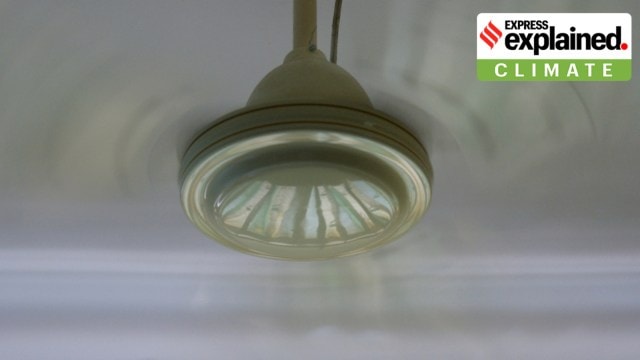Why the Union Budget needs to provide more for energy efficiency measures
Energy efficiency initiatives have delivered massive savings for India over the last two decades. A lot more needs to be done – see how the math works out with a small subsidy for energy-efficient fans
 A government subsidy of Rs 1,000 per fan for 25 million energy-efficient models would cost Rs 2,500 crore and avoid 2.2 billion units (BU) of electricity generation per year. (Wikimedia Commons)
A government subsidy of Rs 1,000 per fan for 25 million energy-efficient models would cost Rs 2,500 crore and avoid 2.2 billion units (BU) of electricity generation per year. (Wikimedia Commons)India’s progress towards energy independence and sustainable development owes much to its progress in energy efficiency. Over the past two decades, these measures have safeguarded the country’s energy security, reducing reliance on imported energy sources and optimising resource usage.
In more recent years, energy efficiency has become a keystone for climate security by helping India decarbonise and edge closer to its climate goals. Energy efficiency alone has contributed to almost one-third of the country’s energy intensity (energy consumption per unit of GDP) reduction between 2005 and 2020.
The stakes are even higher post-pandemic. Resource constraints due to geopolitical tensions have underscored the importance of self-reliance. Energy efficiency is no longer just about conserving resources — it is central to national security and modernising India’s energy and urban infrastructure, reducing import dependence for energy and critical minerals, and positioning the nation as a competitive force on the global stage while contributing to climate goals.
What kind of savings have resulted from India’s energy efficiency initiatives?
Data from the Bureau of Energy Efficiency (BEE) underscore the tremendous impact energy efficiency initiatives have had until now. Consider the following:
- Over 2018-2023, cumulative energy savings from national schemes have amounted to 189 million tonnes of oil equivalent (MTOE), with electricity savings alone accounting for 90 million tonnes (1 MTOE is enough to power over 3 million Indian households for a year).
- In the financial year 2023, energy savings from national schemes resulted in 50.8 MTOE savings with an equal share of thermal and electrical savings.
- In the absence of energy efficiency, India’s energy consumption in 2022-23 would have been 6.6% higher than actuals, equivalent to the energy demand of Tamil Nadu.
- To put the 2022-23 energy savings in perspective, the avoided thermal energy is equivalent to coal usage in 20 power plants (7% of India’s yearly coal consumption), and avoided electricity is equivalent to generation from 80 coal-fired power plants.
- The electricity savings in 2022-23 is equivalent to installing 200 GW solar generation capacity whereas the country has added 97 GW solar till December 2024.
- The economic impact of these savings is equally significant, with a reported INR 1.84 lakh crore in cost reductions during 2022-23, comparable to about 1.1% of India’s GDP.
Why do these efforts need even more attention?
The budgetary allocations for energy efficiency programs remain disproportionately low compared to the allocation for renewable energy.
For instance, in the 2023-24 Union Budget, Rs 19,100 crore was allocated to the Ministry of New and Renewable Energy, while the Bureau of Energy Efficiency received only Rs 230 crore.
Such a difference overlooks the undeniable fact that energy efficiency measures often yield a far higher return on investment compared to renewable energy generation alone.
Consider this simple example of energy-efficient ceiling fans. Ceiling fans are commonplace yet consume substantial electricity, contributing 17.5 GW to peak electricity demand. A government subsidy of Rs 1,000 per fan for 25 million energy-efficient models would cost Rs 2,500 crore. This investment would avoid 2.2 billion units (BU) of electricity generation per year, delivering double the energy savings compared to rooftop solar installations supported through equivalent subsidy size.
In addition to energy savings, energy-efficient fans significantly reduce CO2 emissions, contributing to India’s climate mitigation efforts. As policymakers seek effective energy transition strategies, combining the distribution of energy-efficient appliances with renewable energy initiatives can drive compounded energy savings and emission reductions.
What is the link between energy efficiency and climate security?
We also need to recognise the indispensable role energy efficiency plays in modernising India’s energy and urban systems.
While renewable energy investments are necessary to expand clean energy generation, they alone cannot achieve climate security or energy independence. The annual grid emissions factor has yet to see a meaningful decline, underscoring the urgent need for complementary energy efficiency measures.
Moreover, investing in energy efficiency is not merely about reducing electricity consumption – it is about unlocking systemic savings across generation, transmission, and distribution.
Losses in these areas represent significant economic and environmental costs, equivalent to the output of 55 coal power plants in 2021-22. Reducing these inefficiencies through targeted investments in energy efficiency would free up financial resources that can be redirected toward healthcare, education, and renewable energy projects.
As India seeks to solidify its position as a global leader and become developed, energy efficiency must become a national priority.
The Union Budget 2025 presents an opportunity for the government to recognise energy efficiency as the first fuel in its energy transition. This recognition must be accompanied by robust investment, policy support, and direct schemes designed to tap into the vast potential of energy efficiency measures.
By doing so, India can achieve a clean, resilient, and competitive energy future. Prioritising energy efficiency will not only strengthen the nation’s energy security and climate resilience but also ensure that its economic ambitions are realised sustainably and inclusively.
Pramod Kumar Singh is Senior Director, Research and Programmes, with Alliance for an Energy Efficient Economy (AEEE), a nonprofit energy-efficiency advocacy.
- 01
- 02
- 03
- 04
- 05






































